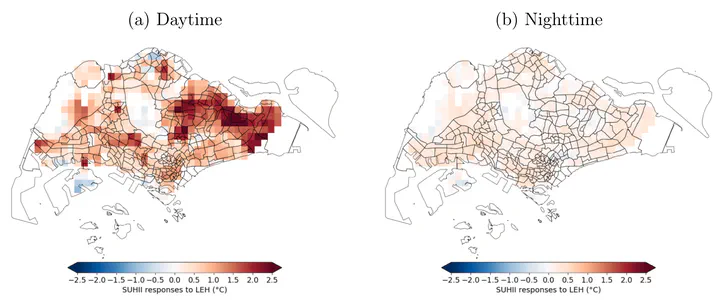Drivers of day-night intra-surface urban heat island variations under local extreme heat: A case study of Singapore

Abstract
Urban areas face significant challenges from extreme heat and urban heat islands (UHIs), which often interact and intensify each other at multi-spatial scales. However, most existing studies examine extreme heat and its interaction with UHIs at the city scale, overlooking the spatial heterogeneity of temperature responses within local areas. Extreme heat does not manifest uniformly across the entire city, and the UHI is a typically localized phenomenon influenced by changes in local climate and urban factors. To address this gap, this study defines local extreme heat (LEH) at the local scale based on 1 km and examines surface urban heat island (SUHI) response to local extreme heat (LEH) in Singapore, a tropical city experiencing more frequent extreme heat events. Using multi-year temperature datasets, we calculated the difference in SUHI intensity (SUHII) between LEH and non-LEH conditions, referred to as SUHII. Our findings revealed that SUHII responses to LEH differed by daytime and nighttime and local areas. Daytime SUHII peaked at 3.2 °C in the northeast, while nighttime SUHII reached 0.6 °C in other regions. To identify the dominant drivers of SUHII responses to LEH, we employed the spatial Random Forest (spatialRF) model. Our results showed that the spatialRF model achieved R-squared values exceeding 63% for predicting daytime SUHII and 45% for nighttime SUHII. LEH, land use, and vegetation dominantly contributed to daytime SUHII, while socioeconomic factors mostly influenced nighttime SUHII. Furthermore, we applied SHAP to interpret the spatialRF model. Hotspots of both daytime and nighttime SUHII were driven by socio-economic factors. Finally, nonlinear associations showed that the cooling effect of vegetation reached saturation, as the SHAP values remained positive, while water bodies, as indicated by a U-shaped SHAP pattern followed by a decline, were more effective in mitigating SUHII increases under LEH conditions.